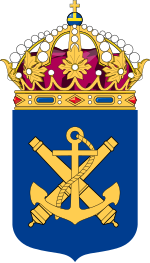Swedish Navy
The Swedish Royal Navy (Swedish: Svenska marinen) is the naval branch of the Swedish Armed Forces. It is composed of surface and submarine naval units – the Fleet (Kungliga Flottan) – as well as marine units, the Amphibious Corps (Amfibiekåren).
In Swedish, vessels of the Swedish Navy are given the prefix "HMS," short for Hans/Hennes Majestäts Skepp (His/Her Majesty's Ship). In English, this is often changed to "HSwMS" ("His Swedish Majesty's Ship") to differentiate Swedish vessels from those of the British Royal Navy.
Early Swedish kings (c. 9th–14th centuries) organised a Swedish Royal Navy along the coastline through ledungen. This involved combined rowing and sailing ships (without artillery). This system became obsolete with the development of society and changes in military technology. No later than in the 14th century, the duty to serve in ledungen was replaced by a tax. In 1427, when Sweden was still part of the Kalmar Union (with Denmark and Norway), Swedish warships did however participate in the naval battle of Öresund (the Sound) against the Hanseatic League. It is unclear how this force was organised and exactly on what basis.
On June 7, 1522, one year after the separation of Sweden from the Kalmar Union, Gustav Vasa purchased a number of ships from the Hanseatic town of Lübeck - official Swedish histories since the 19th century have often recorded this day as the birth of the current Swedish Navy. (The museum ship Vasa in Stockholm was a 17th-century ship of the Royal Swedish Navy (Kungliga flottan)).
...
Wikipedia




